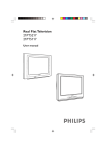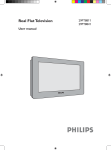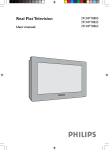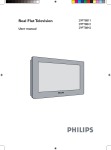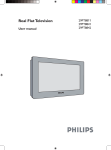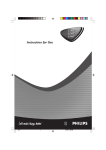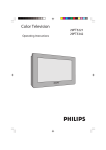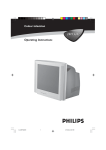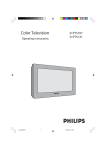Download Philips 21PT2324 21" real flat TV
Transcript
Colour television 21PT2324 21PT2324 Operating instruction cover pg 1-2_21PT2324_71 1 03/25/04, 11:01 AM IMPORTANT Before you begin: Make sure your package includes the following items:TV and mains cord, remote control, Instruction manual, antenna cable (optional) and Coaxial cable (optional). Attention: 1. Read your manual first – your Philips TV comes with a well-designed remote control and onscreen display to ensure your TV is easy to operate. 2. The tips provided in this manual will save you time and money as charges for TV installation and adjustments of customer controls are not covered under the warranty. 3. For information outside of this manual, such as sales locations and other Philips products, please visit www.philips.com which will automatically link you to your local Philips website. 4. Please refer to the ‘Troubleshooting Tips’on page 11 before calling for service. 5. In case of a need to call for service, we recommend you to call from your room where your TV is located and have on hand your remote control, warranty card, TV model and serial number. 6 • • Do not discard packaging materials: without thorough inspection for parts and that accessories that may be packed separately inside the carton. during the warranty period should you need to exchange the set. Recycling: The materials used in your set are either reusable or can be recycled. To minimise environmental waste, specialist companies collect used appliances and dismantle them after retrieving any materials that can be used again (ask your dealer for further details). Disclaimer: Graphics in this manual are for illustration purpose and may not represent the actual product cover pg 1-2_21PT2324_71 2 04/08/04, 2:40 PM Table of Contents Installation Installing your television set . . . . . . . . . . . . . . . . . . . . . . . . . . . . . . . . . . . . . . . . . . . .3 The keys on the TV set . . .. . . . . . . . . . . . . . . . . . . . . . . . . . . . . . . . . . . . . . . . . . . . . .3 Remote control keys . . . . . . . . . . . . . . . . . . . . . . . . . . . . . . . . . . . . . . . . . . . . . . . . . . 4 Language . . . . . . . . . . . . . . . . . . . . . . . . . . . . . . . . . . . . . . . . . . . . . . . . . . . . . . . . . . . . . . .5 Tuner Mode. . . . . . . . . . . . . . . . . . . . . . . . . . . . . . . . . . . . . . . . . . . . . . . . . . . . . . . . . . . . 5 Auto Store . . . . . . . . . . . . . . . . . . . . . . . . . . . . . . . . . . . . . . . . . . . . . . . . . . . . . . . . . . . . 6 Channel Edit . . . . . . . . . . . . . . . . . . . . . . . . . . . . . . . . . . . . . . . . . . . . . . . . . . . . . . . . .. 6 Operation Picture settings . . . . . . . . . . . . . . . . . . . . . . . . . . . . . . . . . . . . . . . . . . . . . . . . . . . . . . . .7 Sound settings. . . . . . . . . . . . . . . . . . . . . . . . . . . . . . . . . . . . . . . . . . . . . . . . . . . . . . . . ..7 Feature settings . . . . . . . . . . . . . . . . . . . . . . . . . . . . . . . . . . . . . . . . . . . . . . . . . . . . . . . .7 Format . . . . . . . . . . . . . . . . . . . . . . . . . . . . . . . . . . . . . . . . . . . . . . . . . . . . . . . . . . . . . . . . 8 Signal Strength . . . . . . . . . . . . . . . . . . . . . . . . . . . . . . . . . . . . . . . . . . . . . . . . . . . . . . . . .8 Active Control . . . . . . . . . . . . . . . . . . . . . . . . . . . . . . . . . . . . . . . . . . . . . . . . . . . . . . . . .9 Personal Zapping . . . . . . . . . . . . . . . . . . . . . . . . . . . . . . . . . . . . . . . . . . . . . . . . . . . . . . 9 Peripherals Video recorder . . . . . . . . . . . . . . . . . . . . . . . . . . . . . . . . . . . . . . . . . . . . . . . . . . . . . . 10 Practical information Tips . . . . . . . . . . . . . . . . . . . . . . . . . . . . . . . . . . . . . . . . . . . . . . . . . . . . . . . . . . . . . . . . . . 11 Glossary . . . . . . . . . . . . . . . . . . . . . . . . . . . . . . . . . . . . . . . . . . . . . . . . . . . . . . . . . . . . . 12 Specification . . . . . . . . . . . . . . . . . . . . . . . . . . . . . . . . . . . . . . . . . . . . . . . . . . . . . . . . ..13 General p1-2_21PT2324_71 Operating manual-21PT2324/71 1 03/25/04, 11:54 AM 1 Safety information • – – – – Disconnect mains plug when : the indicator light below the TV screen is flashing continuously. a bright white line is displayed across the screen. there is a lightning storm. the set is left unattended for a prolonged period of time. • cleaning the TV screen. Never use abrasive cleaning agents. Use a slight damp chamois leather or soft cloth. • No naked flame sources, such as lighted candles, should be placed on top of the TV or in the vicinity. • Do not place your TV set under direct sunlight or heat. • Leave at least 10 cm around each side of TV set to allow for proper ventilation. • Avoid placing your set (e.g. near the window) where it is likely to be exposed to rain or water. • No objects filled with liquids should be placed on top the TV so as to avoid dripping or splashing of liquids on the set. Useful information • Do not leave your set on standby mode for a prolonged period of time. Switch off set to allow it to be demagnetised. A demagnetised set supports good picture quality. • Do not shift or move the set around when it is switched on. Uneveness in colour in some parts of the screen may occur. • Never attempt to repair a defective TV yourself. Always consult a skilled service personnel. 2 Operating manual-21PT2324/71 p1-2_21PT2324_71 2 General 03/25/04, 11:54 AM Installing your television set Positioning the television set Remote control 10 cm 10 cm 10 cm Place your TV on a solid, stable surface, leaving a space of at least 10 cm around the appliance. Connections Insert the two R6-type batteries (supplied) making sure that they are the right way round. The batteries supplied with this appliance do not contain mercury or nickel cadmium. If you have access to a recycling facility, please do not discard your used batteries (if in doubt, consult your dealer). Switching on • • Insert the aerial plug into the x socket at the rear of the set. If you are using an indoor aerial, reception may be difficult in certain conditions. You can improve reception by rotating the aerial. If the reception remains poor, you will need to use an external aerial. Insert the mains plug into a wall socket. Diagram may differ from the actual plug. To switch on the set, press the on/off key. A red indicator means that the television is on standby mode. Refer to the next page on ‘Remote Control keys’ for the various keys that you could use to switch on the set An indicator light will flash when it is receiving signal from the remote control. The keys on the TV set The television set has 4 keys which are located at the front. Installation p3-6_21PT2324_71 The VOLUME – or + key is used to adjust the sound levels. The CHANNEL ^ or v key is used to select channels. To access or exit the main menu, press down the VOLUME – and + keys, simultaneously. To select an item in the main menu, press the CHANNEL ^ or v key. To select an adjustment, press down the VOLUME – or + key. Operating manual-21PT2324/71 3 03/26/04, 2:03 PM 3 Remote control keys Personal Zapping You can surf up to 10 personal channels for each key (p. 9) Sleeptimer Selects a period of time after which the TV will go into standby mode automatically. Standby Lets you place the TV set on standby. To turn on the TV, press CH + or –, 2, AV, A/CH or digit keys. AV channel selection Press several times to select AV and FRONT. Add Personal Zapping list Adds and stores channels into Personal Zapping list (p. 9) Delete Personal Zapping list Deletes stored channels from Personal Zapping list (p. 9) Smart Sound Used to access a series of stored settings: Theatre, Music,Voice or Personal. Smart Picture Used to access a series of stored settings: Rich, Natural, Soft, DVD/VCD or Personal. Menu To call up or exits menus. Cursor These 4 keys are used to move around the menus or provide direct access to the different picture formats (p. 7-9) Volume To adjust the sound level. Digit keys Direct access to the channels. For a 2-digit channel, enter the second digit before the dash disappears. Alternate channel Switched between the current and the previous channel. 4 No function Mute To mute or restore sound. Channel selection To access the next or previous channel. The number and sound mode are displayed for a few moments whenever you select a new channel. On screen display To display/clear the on screen information. Press the key for 5 seconds to activate permanent display of channel number. This key is also used to exit from the menu. Operating manual-21PT2324/71 p3-6_21PT2324_71 4 Installation 04/21/04, 1:54 PM Language When there is no signal input to the TV, you may encounter instability of the screen display. key to select In this instance, please use the an AV channel. The Language feature is used to change the display language for menus. key. & Press the é With the cursor, select the Install menu and follow by the Language. “ Use the key to select a language of your choice. . ‘To quit the menus, press Tuner Mode You can select t Auto, Antenna or Cable modes with this menu. Installation p3-6_21PT2324_71 & Press the key. é With the cursor, select the Install menu and follow by the Tuner Mode. key to select either Auto, “ Use the Antenna or Cable ‘To quit the menus, press . Operating manual-21PT2324/71 5 03/25/04, 11:56 AM 5 Auto Store This menu is used to store all available channels automatically. & Press the key. é With the cursor, select the Install menu and follow by the Auto Store. All the available TV channels will be stored. This operation takes a few minutes. The display shows the progress of the search and the number of channels found. At the end of the search, the menu disappears. To exit or interrupt the search, press . If no channels are found, consult the possible solutions on p.11. Channel edit This feature allows you to skip or edit channels which have bad or weak TV signal or channels you do not watch often. Once a channel is skipped, you cannot have access to it by the Channel + or – key.You can only access the channels by the digit (0-9) keys. & Press the key. The Main menu is displayed on the screen. é With the cursor, select the Install menu followed by the Channel Edit menu. “ Enter into the menu and select the channel number you wish to skip by the digit keys. ‘ Then use the key to select Skipped. Use the key to select On. ( Repeat steps “ and ‘ for each channel you wish to skip. § To quit the menus, press . To restore skipped channels & Repeat steps & to “ above. é Use the key to select Skipped and the key to select Off. “ Repeat steps & and é for each channel you wish to skip. ‘ To quit the menus, press . 6 Operating manual-21PT2324/71 p3-6_21PT2324_71 6 Installation 04/21/04, 1:54 PM Picture settings & Press then displayed: . The Picture menu is é Use the or keys to select a setting and the or keys to adjust. Note: during the picture adjustment, only the selected line remains displayed. Press or to display the menu again. to exit. “ Press Description of the adjustments: • Brightness: this changes picture brillance. • Colour: this changes the intensity of the colour. • Contrast: this changes the difference between the light and dark tones. • Sharpness: this changes the picture definition. • Hue: this adjusts the skin colour tone. • Colour Temp.: this changes the colour rendering: Cold(bluer), Normal(balanced) or Warm(redder). • NR: attenuates picture noise (snow) in difficult reception conditions. • Contrast +: automatic adjustment of the picture contrast which permanently sets the darkest part of the picture black. Sound settings & Press , select Sound ( ) and press . The Sound menu is displayed. ge é Use the or or and the “ Press to exit. Description of the adjustments: • Treble Boost: this alters the high frequency sounds. • Bass Boost: this alters the low frequency sounds. • AVL (Automatic Volume Leveller): this is used to limit increases in sound, especially on channel change or advertising slots. key to select a setting key to adjust. Features settings & Press , select Features ( ) and press . The Features menu is displayed: Operation p7-9_21PT2324_71 Description of the features: • Format: see explanation on the next page. • Signal Strength : see explanation on the next page. • Active Control : see explanation on the next page. Operating manual-21PT2324/71 7 04/21/04, 1:56 PM 7 Format This feature enhances your viewing pleasure by providing you with a choice of two picture formats:- 4:3 and Expand 4:3. & Press , use the or key to select Features and press the key. The Features menu is displayed. é Use the key to select Format and press the key to select 4:3 or Expand 4:3. key to exit. “ Press the Description of function: 4:3 – select this format if you want to display a conventional picture using the full surface of the screen. 4:3 Expand 4:3 – select this format if you want to expand pictures transmitted in a ‘letterbox’ format (black horizontal bars at the top and bottom of the screen) to fill up the entire screen. Letterbox Expand 4:3 Signal Strength This feature display the signal strength level at the bottom of the screen. Select the option ON to activate the display each time you switch to a new channel. or key to select & Press , use the Features and press the key. The Features menu is displayed. 8 or key to select é Use the Signal Strength and press the to select On. key to exit. “ Press the Operating manual-21PT2324/71 p7-9_21PT2324_71 8 key Operation 03/25/04, 11:42 AM Active Control The Active Control monitors and adjusts incoming video signals to help provide the best picture quality.When you choose to turn the Active Control to On or Display On, the Brightness, Contrast, Sharpness, Contrast+ and NR (noise reduction) features are controlled automatically. Active Control adjusts these picture settings continuously and automatically & Enter Features menu as described in “Features settings” on the previous page. key to select Active Control é Use the and press the key to select Off, On or Display On. “ Press the key to exit. Description of option: Off: the Active Control will not be activated. On: the Active Control will work to give the viewer the best possible picture, but will not display the monitoring screen when channels are changed. Display On: an Active Control monitoring screen will be shown for a few seconds whenever a channel is changed. Active Control Monitoring Screen Personal Zapping A list or series of favourite TV programs can be selected and stored in the 4 coloured keys with the Personal Zapping feature. With this feature you can easily viewed up to a total of 10 preferred channels for each coloured key. To add channels: & Select a channel with the digit keys. to display list. é Press “ Press your favourite colour key to store the channel in step &. ‘ Repeat steps &to “ to store more channels. to exit. ( Press To delete channels: & Select and press a colour key that has stored channels repeatedly to select the channel you want to delete. éPress to display list. to remove channel. “Press ‘Repeat steps &to “delete more channels. (Press to exit. To view channels: Select and press a colour key that has stored channels repeatedly to select the channel you want to view. Operation p7-9_21PT2324_71 Operating manual-21PT2324/71 9 03/26/04, 2:08 PM 9 Connecting peripheral equipment The television has 2 external sockets situated at the back of the set Video recorder & Connect the TV’s yellow and white (AV1 in) jacks to the corresponding Video and Audio jacks on the player. é Connect the TV’s white AUDIO IN jacks to the corresponding AUDIO OUT jacks on the player. Match the cable colour to the jacks’ colour. The white jack is the Left (Mono) audio channel. “ Turn on the TV and VCR player. Set the TV to AV1. You can now play your video cassette tape. Connection is also possible via the aerial cable. You will therefore need to tune in your video recorder’s test signal and assign a channel number 0. Select channel 0 to playback. 10 Operating manual-21PT2324/71 p10_21PT2324_71 10 Peripherals 04/21/04, 1:59 PM Tips Poor reception The proximity of mountains or high buildings may be responsible for ghost pictures, echoing or shadows. In this case, try skipping channels with bad or weak TV signals: see “Channel Edit” (p. 6) or modify the orientation of the outside aerial. Does your antenna enable you to receive broadcasts in this frequency range (UHF or VHF band)? In the event of difficult reception (snowy picture) switch the NR on the Picture menu to ON (p. 7). Good sound but poor colour or no picture Try to increase the contrast and brightness setting. No picture If the television does not switch on, press (located on the the standby key remote control) twice. Have you connected the aerial socket properly? Have you chosen the right tuner mode? (p. 5). Poorly connected aerial sockets are often the cause of picture or sound problems (sometimes the connectors can become disconnected if the TV set is moved or turned). Check all connections. Double or “Ghost” images Possible poor positioning of antenna. Using a high directional antenna may improve reception. Colour patches on screen Switch off the TV by the mains poer button and wait for about 20 minutes before switching on again. Good picture but no sound Try to increase the volume level. Check that the sound is not set to “mute”. If it is, key to restore the sound. press the Practical information p11-14_21PT2324_71 Snowish picture and noise Check antenna connection at the rear of the TV. Horizontal dotted lines Possible electrical interference e.g. hairdryer, vacuum cleaner, etc. Switch off the appliances. Peripheral equipment gives a black and white picture You have not selected the socket connection to the right channel with the key: for example, AV1 in socket connection should select channel AV1 to playback. To play a video cassette, check that it has been recorded under the same standard (PAL, SECAM, NTSC) which can be replayed by the video recorder. The remote control does not work Check that the batteries are the right way round and there is no obstruction between the remote control and the TV. If the light indicator on the set no longer flashes when you use the remote control, replace the batteries. Operation manual-21PT2324/71 11 03/25/04, 12:02 PM 11 Glossary 4:3 Refers to the ration between the length and the height of the screen. Wide screen televisions have a ration of 16:9 while conventional televisions have a ratio of 4:3. 4:3 Expand The images recorded in “letterbox” format are expanded to fill the entire screen and the black horizontal bars at the top and bottom are removed. Active Control Is a unique, intelligent, and proactive control system, which measures and analyzes the incoming analog signal 60 times per second to automatically adjust settings for optimal picture quality. It also uses a sensor to adjust for ambient room light; when the room gets brighter, so does the picture. Contrast+ enhances the darker portions of the picture to improve its picture quality. Personal Zapping A Philips trade marked feature which allows any combination of favourite teletext pages or TV channels to be stored in the coloured Favourite Channels/Teletext keys. A total of 10 preferred channels/teletext pages of the same subject or user can be stored in each coloured key. 12 Operating manual-21PT2324/71 p11-14_21PT2324_71 12 Practical information 03/25/04, 12:02 PM Specification Product type 21PT2324/71 PICTURE • Picture screen diameter: 525 mm • Visible screen size: 510 mm • Smart Picture Modes • Brightness Control • Colour Control • Contrast Control • Sharpness Control • Colour Temperature Control • Contrast Plus • Noise Reduction • Active Control • Signal Strength Indicator Ease of use • Multi language on screen display • Personal Zapping • Alternate channel • Sleeptimer Size and weight • Set dimensions: L x D x H mm (522 x 479 x 461) mm • Net weight: 23.2 kg Sound • Sound output: 1 x 4 W • Loudspeakers: Full range • Smart Sound Modes • Auto volume Leveller Reception • Tuning system: PLL digital tuning • Tuner: UV, S and Hyperband • Channel Selection: 125 presets, Full cable • Aerial input: 75 ohm coaxial • TV System: NTSC M (3.58-4.5) • Video playback: NTSC 3.58, NTSC 4.43, NTSC Palyback, PAL 60 Connectors • Rear: Stereo Audio/Video input x 2 Stereo Audio/Video output x 1 Component Video Input S-Video input Specification subject to change without notice. Practical information p11-14_21PT2324_71 Operation manual-21PT2324/71 13 04/08/04, 2:40 PM 13 3141 055 22931 p11-14_21PT2324_71 14 03/25/04, 12:02 PM

















